Several months ago, we found a bargain for a giant edition of Snakes and Ladders (or maybe chutes and ladders, depending on where you grew up), and we excitedly brought it home to play with our two beans. Unfolding the giant plastic mat onto the floor, setting up with palm-sized pawns, and feeling the weight of the oversized die in our hands, all signs pointed to it being a wonderful family gaming experience. Moments later, the pawns had been thrown across the room, the plastic had been rolled into a bunchy ball, and the die was nowhere to be found. Why did our classic gaming experience devolve into gunky chaos and hurt feelings? We’ll come back to that in a few paragraphs.
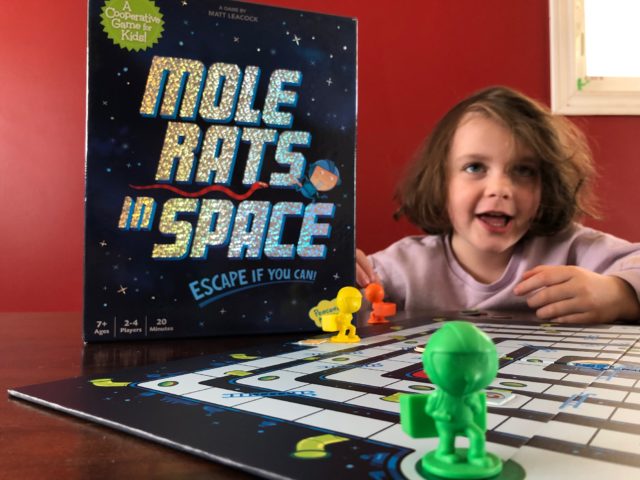
Mole Rats in Space is a cooperative game published in 2017 by Peaceable Kingdom, with a design from the King of Co-ops, Matt Leacock, and art by Jim Paillot. Players each control their own Mole Rat, who are collectively on a mission to collect four essential equipment items, and reach their escape pod in the centre of the board before the nasty space snakes either bite them or reach the pod themselves!
Inside the box sits a delghtfully functional insert, which contains the following components – four plastic Mole Rat figures, a deck of 46 cards, a variety of cardboard tokens (medkits, snakes, equipment), and the board. Ooh, and there’s a secret challenge envelope included, that can only be opened once the game has been won three times!
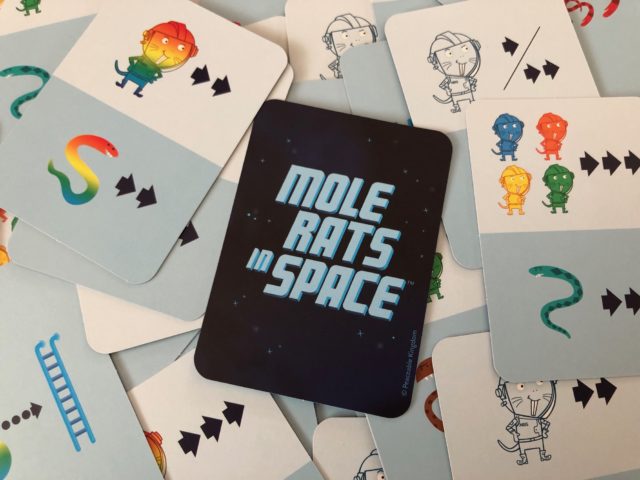
The board is a space station composed of five square-shaped rings, connected by a variety of ladders and tubes. Ladders can be traversed up, and the slidey Tubes only go down towards the outer rings of the board. Some tubes even lead right off the station entirely! As mentioned earlier, the goal is to collectively collect the four essential pieces of equipment, and drop them at the escape pod in the middle of the board.
Driving the momentum of the game is the deck of cards, which feature a maximum of 2 instructions to carry out – either for the heroic Mole Rats, or the nasty Snakes. Arrow icons indicate the number of spaces to move, ranging between 1 and 3 spaces. If a playing piece lands at the base of a Ladder or Air Shaft, only then is that element triggered, not unlike the traditional ups and downs of Snakes and Ladders.
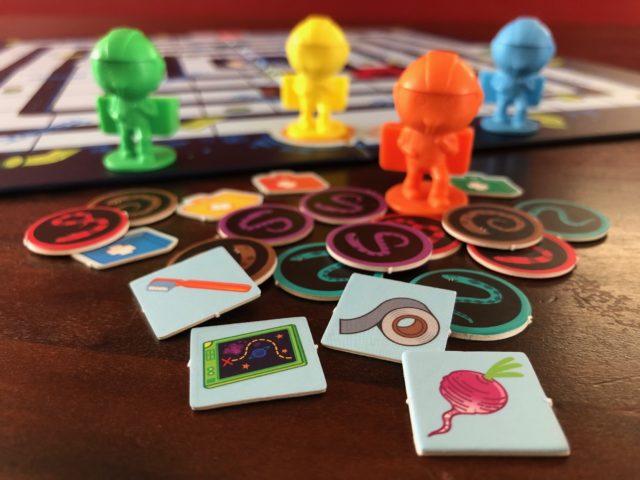
The components for Mole Rats in Space are adorable, and contribute to an intuitive experience for both big and little players alike. Perhaps the most satisfying element is the little backpack on each Mole Rat, which has a pouch opening to hold the critical equipment. It’s impossible to forget which items have been delivered to the escape pod when the Mole Rats are literally carrying them there. Our only component gripe would be the thickness of the cardboard tokens, which are easy to lose track of, especially if they fall off the table to the floor of a busy family home. Otherwise, we’re all super happy with the bits and bobs of this game!
How about the gameplay itself? While our classic Snakes & Ladders experiences have been frustrating at best, we’re pleased to report that Mole Rats in Space did not result in tears and screams. So how does Matt Leacock’s game succeed where the old timey Snakes & Ladders failed us? I believe there are three key elements that elevate this game – Cooperation, Narrative, and Meaningful Movement Decisions.
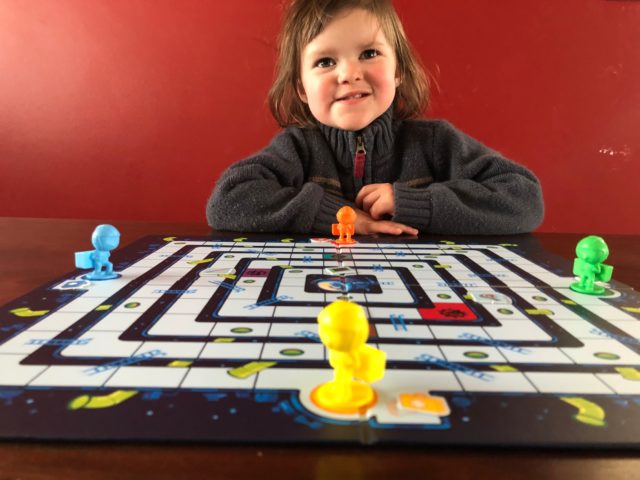
Cooperation – While the classic game is a race to see who can reach the end goal first, Mole Rats is all about working together to succeed. Competition doesn’t always lead to a positive play experience, and we’re happy that Mole Rats encourages cooperation!
Narrative – The story of collecting key pieces of equipment and safely escaping from the space snakes is an easy one to follow! Even when the attention of little eyes wander away from the game, the story helps everyone to refocus and finish the game.
Meaningful Decisions – Most turns allow the active player to decide which direction the Mole Rats (or Snakes) move. Sometimes, every direction is blocked by the snakes, but there’s usually an option that avoids a bite!
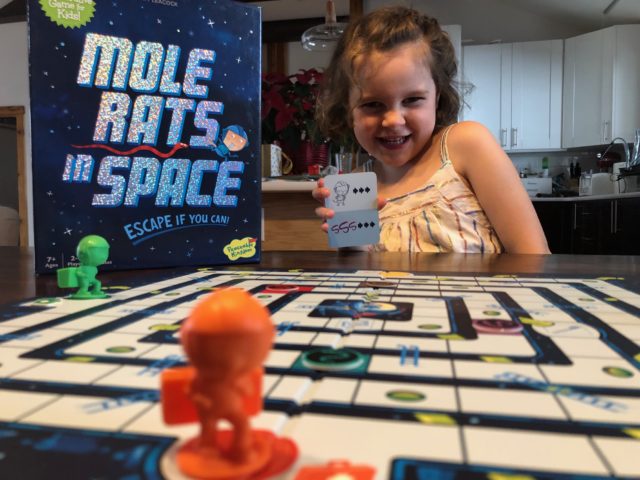
As of this writing, my beans are 3 and 4 years old. How did they take to this game as young players?
Big Bean is about a month away from turning 5, and she mostly grasped the basic concepts of movement, item pickup, and making it to the middle of the board. Many turns, we would present her with the options and suggest what the positive and negative outcomes of those actions might be, ultimately leaving the decision in her hands. She was engaged throughout, and had a lot of fun!
Little Bean has just turned 3, and isn’t quite ready for a game of this complexity. We set up the game a few times and attempted to guide her through a couple of turns, but the focus just isn’t there yet. Counting the arrows on the cards held her attention, but translating that count to moving pieces on the board was a bit of a challenge.
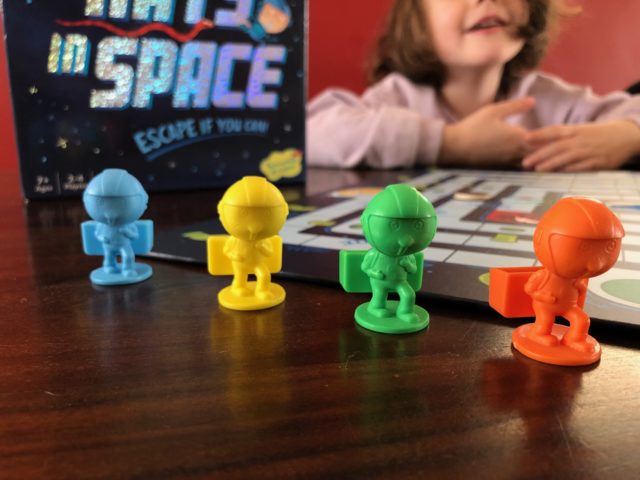
As for us big kids, my wife and I have really enjoyed playing Mole Rats in Space as an occasional game option. The chaotic nature of the card draw ensures that there are moments of difficulty, and that some end game situations simply are not winnable. An added bonus is that this game can be played solo, with the player choosing to control 2, 3 or 4 Mole Rats. We likely wouldn’t pick this game over our favourite adult-focused co-op games, but as a quick appetizer of a game, it’s been enjoyable and satisfying!
Let’s go to the thumbs for a final verdict …
Big Bean’s Little Thumbs : UP!
Mommy and Daddy’s Big Thumbs : UP!
Mole Rats in Space is a co-operative game featuring elements of pick up an deliver, published by Peaceable Kingdom, with a design from Matt Leacock and artwork by Jim Paillot. The game plays in about 20 minutes, and is intended for 2 to 4 players, suggested for players 7 and up.
Comments
No comments yet! Be the first!